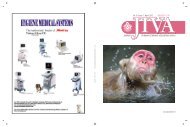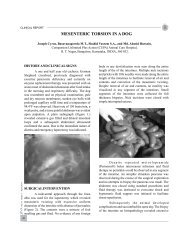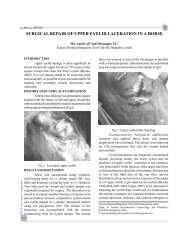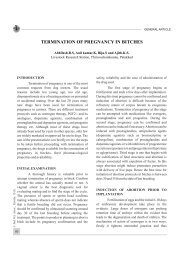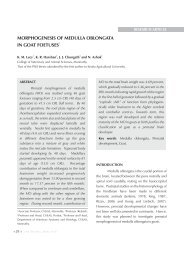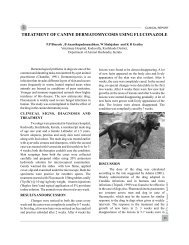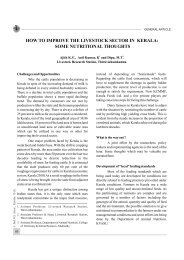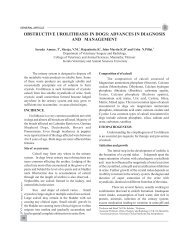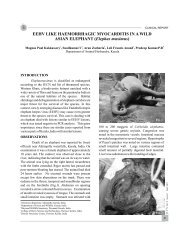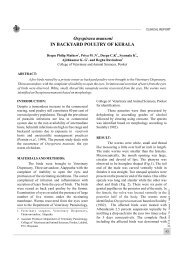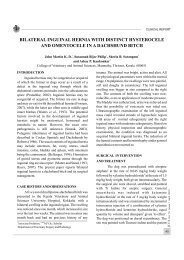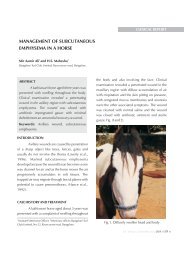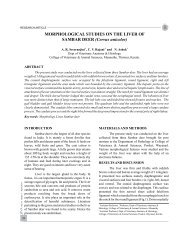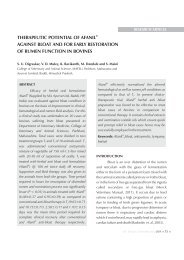socio-personal profile of tribal livestock farmers in ... - Jivaonline.net
socio-personal profile of tribal livestock farmers in ... - Jivaonline.net
socio-personal profile of tribal livestock farmers in ... - Jivaonline.net
You also want an ePaper? Increase the reach of your titles
YUMPU automatically turns print PDFs into web optimized ePapers that Google loves.
RESEARCH ARTICLE<br />
SOCIO-PERSONAL PROFILE OF TRIBAL LIVESTOCK FARMERS IN<br />
RELATION TO DEGREE OF BELIEF AND EXTENT OF ADOPTION OF<br />
SELECTED INDIGENOUS ANIMAL HUSBANDRY PRACTICES.*<br />
1 2 3 3 4<br />
Bimal. P. Bashir , P.J. Rajkamal , Reeja George P. , Rajeev T. S. and K.A.Mercey<br />
College <strong>of</strong> Veter<strong>in</strong>ary and Animal Sciences, Mannuthy, Thrissur.<br />
*Part <strong>of</strong> M.V.Sc. Thesis submitted by the first author to Kerala agricultural University, Thrissur.<br />
ABSTRACT<br />
The present study was undertaken with the objective <strong>of</strong> study<strong>in</strong>g the <strong>socio</strong>-<strong>personal</strong> <strong>pr<strong>of</strong>ile</strong> <strong>of</strong> <strong>tribal</strong> Animal<br />
Husbandry <strong>farmers</strong> <strong>in</strong> relation to the degree <strong>of</strong> belief and extent <strong>of</strong> adoption <strong>of</strong> <strong>in</strong>digenous animal husbandry<br />
practices. Stratified proportionate random sampl<strong>in</strong>g procedure was adopted. One hundred and twenty <strong>tribal</strong><br />
<strong>livestock</strong> <strong>farmers</strong> were selected from all the three panchayats viz., Agali, Pudur and Sholayoor <strong>of</strong> Attappady block. A<br />
pilot study was conducted to identify various <strong>in</strong>digenous animal husbandry practices, which were prevalent <strong>in</strong> the<br />
area, through <strong>personal</strong> observation, group <strong>in</strong>terviews <strong>of</strong> <strong>tribal</strong> animal husbandry <strong>farmers</strong>, discussion with local<br />
healers, head clan ('Moopan') and such other key <strong>in</strong>formants. A total <strong>of</strong> 53 beliefs/ practices were selected for the<br />
f<strong>in</strong>al study. It was found that age and years <strong>of</strong> experience <strong>in</strong> animal husbandry were positively and significantly<br />
correlated with degree <strong>of</strong> belief and extent <strong>of</strong> adoption <strong>of</strong> <strong>in</strong>digenous animal husbandry practices, whereas herd size<br />
and literacy had no significant correlation with degree <strong>of</strong> belief and extent <strong>of</strong> adoption <strong>of</strong> <strong>in</strong>digenous animal<br />
husbandry practices.<br />
JIVA Vol. 9 Issue 2 August 2011<br />
INTRODUCTION<br />
In the field <strong>of</strong> animal husbandry, <strong>tribal</strong> societies have<br />
nurtured a vast fund <strong>of</strong> <strong>in</strong>digenous knowledge and<br />
practices. But they are sparsely documented and<br />
studied. These <strong>in</strong>digenous practices may be an<br />
alternative or complementary to modern technology<br />
and can generate ideas for future research.<br />
Indigenous knowledge <strong>in</strong> animal husbandry exists as<br />
beliefs that are transferred from generation to<br />
generation through folklore <strong>of</strong> people. These are<br />
mostly unwritten and are only recorded <strong>in</strong> the human<br />
m<strong>in</strong>d. Grenier (1998) def<strong>in</strong>ed <strong>in</strong>digenous knowledge<br />
as unique, traditional, local knowledge exist<strong>in</strong>g<br />
with<strong>in</strong> and developed around the specific conditions<br />
<strong>of</strong> women and men <strong>in</strong>digenous to a particular<br />
geographic area. Some <strong>of</strong> the synonyms <strong>of</strong><br />
<strong>in</strong>digenous knowledge accord<strong>in</strong>g to Seeland (2000)<br />
were 'traditional knowledge', 'folk knowledge', 'local<br />
knowledge' and 'wisdom <strong>of</strong> the elders'.<br />
Attappady, the location <strong>of</strong> the present study, is the<br />
largest <strong>tribal</strong> settlement area <strong>of</strong> Kerala. The <strong>tribal</strong><br />
folk <strong>of</strong> Attappady are the most backward among<br />
vulnerable ethnic groups <strong>of</strong> the state. They have a<br />
16<br />
traditional economy depend<strong>in</strong>g ma<strong>in</strong>ly on land,<br />
<strong>livestock</strong> and forest. The population <strong>of</strong> Attappady (2001<br />
Census) was 66,171 <strong>of</strong> which 27,121 belong to<br />
scheduled tribes. Tribes constitute about 41% <strong>of</strong> total<br />
population <strong>of</strong> Attappady, which comprises ma<strong>in</strong>ly <strong>of</strong><br />
three ethnic groups, viz., “Irula”, “Kurumba” and<br />
“Muduga”.<br />
MATERIAL AND METHODS<br />
Attappady <strong>tribal</strong> block <strong>of</strong> Palakkad district was<br />
selected as the area <strong>of</strong> study. This <strong>tribal</strong> block is<br />
comprised <strong>of</strong> three panchayats which are Agali, Pudur<br />
and Sholayoor. Ten hamlets each from peripheral and<br />
deep areas were purposefully selected. Sixty<br />
respondents each were selected from the hamlets <strong>of</strong><br />
peripheral and deep area follow<strong>in</strong>g a stratified<br />
proportionate random sampl<strong>in</strong>g procedure. The present<br />
study was conducted <strong>in</strong> 2009. A pilot study was<br />
conducted to identify various <strong>in</strong>digenous animal<br />
husbandry practices which are prevalent <strong>in</strong> the area.<br />
Personal observations, group <strong>in</strong>terviews <strong>of</strong> <strong>tribal</strong> animal<br />
1 2 3<br />
MVSc. Scholar, Pr<strong>of</strong>essor and Head, Assistant Pr<strong>of</strong>essor<br />
Department <strong>of</strong> Veter<strong>in</strong>ary and Animal Husbandry Extension<br />
4<br />
Associate Pr<strong>of</strong>essor, Department <strong>of</strong> Statistics<br />
College <strong>of</strong> Veter<strong>in</strong>ary and Animal Sciences, Mannuthy, Thrissur.
husbandry <strong>farmers</strong>, discussion with local healers, head<br />
clan ('Moopan') and such other key <strong>in</strong>formants were<br />
conducted to document the various beliefs and<br />
practices. A total <strong>of</strong> 53 belief based practices were<br />
selected for the f<strong>in</strong>al study.<br />
Operationalisation and measurement <strong>of</strong> variables<br />
a) The Socio-<strong>personal</strong> variables selected were age,<br />
literacy, occupation, years <strong>of</strong> experience <strong>in</strong> animal<br />
husbandry and herd size.<br />
b) The dependent variables selected were degree <strong>of</strong><br />
belief <strong>in</strong> the selected <strong>in</strong>digenous animal husbandry<br />
practices and extent <strong>of</strong> adoption <strong>of</strong> selected<br />
<strong>in</strong>digenous animal husbandry practices.<br />
i.) Degree <strong>of</strong> belief <strong>in</strong> the selected <strong>in</strong>digenous animal<br />
husbandry practices<br />
Degree <strong>of</strong> belief was conceptualized as the level<br />
<strong>of</strong> agreement or disagreement <strong>of</strong> the respondent with the<br />
selected beliefs that the respondents were aware <strong>of</strong>. The<br />
respondents were <strong>in</strong>dividually rated over all the beliefs<br />
on a five po<strong>in</strong>t cont<strong>in</strong>uum viz., strongly agree, agree,<br />
undecided, disagree and strongly disagree with<br />
respective weighages <strong>of</strong> 5, 4, 3, 2 and 1. Accord<strong>in</strong>gly<br />
respondents were categorized <strong>in</strong>to two as strong<br />
(>mean) i.e., (>172.5) and weak (
RESEARCH ARTICLE<br />
ii.) Literacy<br />
Table no. 2 Distribution <strong>of</strong> respondents based on literacy. n=120<br />
Indigenous animal husbandry practices<br />
Category Respondents Strong believers Weak believers<br />
Illiterate 76 (63.33) 36 (47.37) 40 (52.63)<br />
Literate 44 (36.67) 17 (38.64) 27 (61.36)<br />
Total 120 (100) 53 (44.17) 67 (55.83)<br />
Based on occupation the respondents were<br />
categorized <strong>in</strong>to those belong<strong>in</strong>g to the agricultural<br />
sector and non-agricultural sector (Table 3). Out <strong>of</strong><br />
the total 120 respondents, 41.67 percent belonged to<br />
the agricultural sector and 58.33 percent belonged to<br />
non-agriculture sector.<br />
Weak believers <strong>of</strong> <strong>in</strong>digenous animal husbandry<br />
practices were more (68.0%) than strong believers<br />
(32.0%) among the agriculture category. On the<br />
practices were more among the non-agricultural<br />
category. This is <strong>in</strong> spite <strong>of</strong> the fact that non-agricultural<br />
category <strong>in</strong>cluded petty bus<strong>in</strong>essmen / traders, nonagricultural<br />
labourers and government servants.<br />
In the case <strong>of</strong> <strong>in</strong>digenous animal husbandry<br />
practices, among the highly experienced group, strong<br />
believers (68.18%) were more than weak believers<br />
(31.81%). But among the low experience group there<br />
were more weak believers (92.31%) than strong<br />
iii.) Occupation<br />
Table no. 3 Distribution <strong>of</strong> respondents based on occupation n=120<br />
Indigenous animal husbandry practices<br />
Category Respondents Strong believers Weak believers<br />
Agricultural sector 50 (41.67) 16 (32.0) 34 (68.0)<br />
Non agricultural sector 70 (58.33) 37 (52.86) 33 (47.14)<br />
Total 120 (100) 53 (44.17) 67 (55.83)<br />
JIVA Vol. 9 Issue 2 August 2011<br />
contrary, strong believers were more (52.86%) than<br />
weak believers (45.71) among the non-agriculture<br />
category. In the overall sample there were 44.17<br />
percent strong believers and 55.83 percent weak<br />
believers regard<strong>in</strong>g <strong>in</strong>digenous animal husbandry<br />
practices.<br />
In the past the livelihood <strong>of</strong> <strong>tribal</strong> people was<br />
dependent solely upon cultivation, animal husbandry<br />
and sale <strong>of</strong> forest produce. But today, the situation<br />
seems to have changed s<strong>in</strong>ce this study brought to<br />
light the fact that for majority <strong>of</strong> the respondents<br />
major occupation is non-agriculture job. This<br />
observation agreed with that <strong>of</strong> Velluva (2004).<br />
Strong believers <strong>of</strong> <strong>in</strong>digenous animal husbandry<br />
18<br />
believers (7.69%). In the medium group, there were 50<br />
percent each <strong>of</strong> strong and weak believers. In the overall<br />
sample there were 44.17 percent strong believers and<br />
55.83 percent weak believers regard<strong>in</strong>g <strong>in</strong>digenous<br />
animal husbandry practices.<br />
60 percent <strong>of</strong> the respondents possessed small herd size<br />
were as 40 percent possessed large (Table 5). In the case<br />
<strong>of</strong> <strong>in</strong>digenous animal husbandry practices, among the<br />
small herd size category, 44.44 percent were strong<br />
believers and 55.56 percent were weak believers.<br />
Among the large herd size category, 43.75 percent were<br />
strong believers and 56.25 percent were weak believers.<br />
In the overall sample there were 44.17 percent strong<br />
believers and 55.83 percent weak believers regard<strong>in</strong>g<br />
<strong>in</strong>digenous animal husbandry practices.
iv.) Years <strong>of</strong> experience <strong>in</strong> Animal Husbandry<br />
Table no.4 Distribution <strong>of</strong> respondents based on years <strong>of</strong> experience <strong>in</strong> Animal Husbandry.<br />
n=120<br />
Indigenous animal husbandry practices<br />
Category Respondents Strong believers Weak believers<br />
High (> 37 years) 22 (18.33) 15 (68.18) 7 (31.81)<br />
Medium (13 37 years) 72 (60.0) 36 (50.0) 36 (50.0)<br />
Low (8.7) 48 (40.0) 21 (43.75) 27 (56.25)<br />
Small (
RESEARCH ARTICLE<br />
degree <strong>of</strong> belief and extent <strong>of</strong> adoption <strong>in</strong> <strong>in</strong>digenous<br />
animal husbandry practices <strong>in</strong>dicat<strong>in</strong>g that illiterates<br />
had a more favourable attitude towards <strong>in</strong>digenous<br />
animal husbandry practices and eventually they were<br />
the majority among strong believers <strong>of</strong> <strong>in</strong>digenous<br />
animal husbandry practices.<br />
Degree <strong>of</strong> belief <strong>of</strong> <strong>in</strong>digenous animal<br />
husbandry practices was significantly and positively<br />
correlated with years <strong>of</strong> experience <strong>in</strong> animal<br />
husbandry. This agreed with the f<strong>in</strong>d<strong>in</strong>gs <strong>of</strong><br />
Ganadeepa (1991), Kalaivany (1992) and Sunil<br />
(2001) but was contrary to the f<strong>in</strong>d<strong>in</strong>g <strong>of</strong><br />
Selvanayagan (1986). The extent <strong>of</strong> adoption <strong>of</strong><br />
<strong>in</strong>digenous animal husbandry practices was<br />
positively and highly significantly correlated with<br />
experience. This agreed with the f<strong>in</strong>d<strong>in</strong>gs <strong>of</strong><br />
Somasundaram (1995) and Sunil (2001). The highly<br />
significant correlation could be because more<br />
experienced dairy <strong>farmers</strong> had comparatively more<br />
faith <strong>in</strong> <strong>in</strong>digenous animal husbandry practices.<br />
The degree <strong>of</strong> belief <strong>in</strong> <strong>in</strong>digenous animal<br />
husbandry practices were positively and nonsignificantly<br />
correlated with the herd size. This<br />
observation agreed with that <strong>of</strong> Sunil (2001). The<br />
extent <strong>of</strong> adoption <strong>of</strong> <strong>in</strong>digenous animal husbandry<br />
practices was also positively and non-significantly<br />
correlated with herd size. This observation disagreed<br />
with the f<strong>in</strong>d<strong>in</strong>g <strong>of</strong> Sunil (2001) and Somasundaram<br />
(1995). The positive correlation <strong>in</strong>dicated that those<br />
with large herd size had more faith <strong>in</strong> the degree <strong>of</strong><br />
belief and extent <strong>of</strong> adoption <strong>of</strong> <strong>in</strong>digenous animal<br />
husbandry practices<br />
To conclude the study revealed that mostly<br />
youngsters are not <strong>in</strong>terested <strong>in</strong> <strong>in</strong>digenous practices<br />
and age and experience <strong>in</strong> A.H have got a significant<br />
relationship with adoption <strong>of</strong> <strong>in</strong>digenous practices.<br />
ACKNOWLEDGEMENT<br />
Facilities provided by Dean, College <strong>of</strong> Veter<strong>in</strong>ary and<br />
Animal Sciences and Kerala Agricultural University are<br />
thankfully acknowledged.<br />
REFERENCES<br />
Anonymous. 2001. Census report. Scheduled Tribes<br />
Department, Govt. <strong>of</strong> Kerala<br />
Ganadeepa, A. (1991). Techno-cultural Pr<strong>of</strong>ile <strong>of</strong> rice<br />
<strong>farmers</strong>. Unpub. M.Sc. (Ag). Thesis, T.N.A.U.,<br />
Coimbatore.<br />
Grenier, L. (1998). Work<strong>in</strong>g with Indigenous Knowledge - A<br />
guide for researchers, Ottawa: IDRC, 100p.<br />
Kalaivany, S. (1992). Techno-cultural <strong>pr<strong>of</strong>ile</strong> <strong>of</strong> Gardenland<br />
<strong>farmers</strong>. Unpub. M.Sc. (Ag). Thesis, T.N.A.U.,<br />
Coimbatore.<br />
Ramkumar, S. (1987). Impact <strong>of</strong> correspondence course <strong>in</strong><br />
dairy<strong>in</strong>g and adoption <strong>of</strong> improved dairy practices.<br />
Unpub. M.V.Sc. Thesis, Department <strong>of</strong> Extension,<br />
College <strong>of</strong> Veter<strong>in</strong>ary and Animal Sciences,<br />
Mannuthy, Thrissur, India, pp 59-70.<br />
Seeland, Klaus (2000). What is <strong>in</strong>digenous Knowledge and<br />
why does it matter today? In. Seeland, Klaus and<br />
Schmithusen, F., (eds.) Man <strong>in</strong> the forest- local<br />
Knowledge and Susta<strong>in</strong>able Management <strong>of</strong> Forest<br />
and Natural Resources <strong>in</strong> Tribal Communities <strong>in</strong><br />
India, New Delhi: DK Pr<strong>in</strong>t world, pp.33-47<br />
Selvanayagam, M. (1986). Techno-cultural <strong>pr<strong>of</strong>ile</strong> <strong>of</strong> dryland<br />
farm<strong>in</strong>g. Unpub. M.Sc. (Ag). Thesis, T.N.A.U.,<br />
Coimbatore.<br />
Somasundaram, S. (1995). Indigenous Knowledge <strong>in</strong> farm<strong>in</strong>g<br />
system. Unpub. Ph.D. Thesis, Department <strong>of</strong><br />
Extension. T.N.A.U., Coimbatore.<br />
Sunil, G. 2001. A study <strong>of</strong> the traditional belief system <strong>in</strong> dairy<br />
husbandry among <strong>tribal</strong>s <strong>of</strong> Attappady. M.V.Sc.<br />
Thesis, Kerala Agricultural University,Thrissur, 114 p.<br />
Velluva, S. 2004. Developmental Effects on livelihood strategies<br />
<strong>of</strong> Tribal people <strong>in</strong> Attappady, Kerala, Discussion Paper,<br />
Kerala Research Programme on Local Level<br />
Development, C.D.S, Thiruvananthapuram, pp. 1-59<br />
JIVA Vol. 9 Issue 2 August 2011<br />
20



